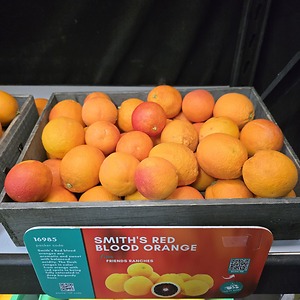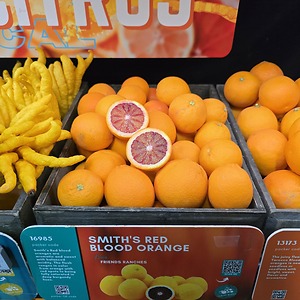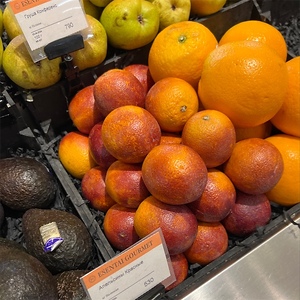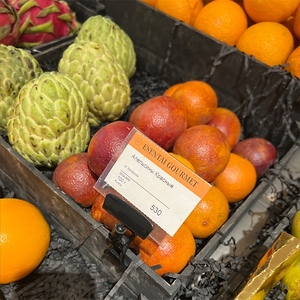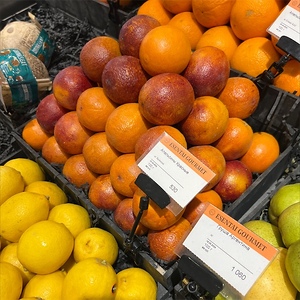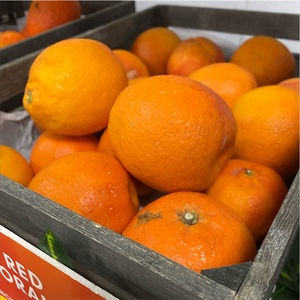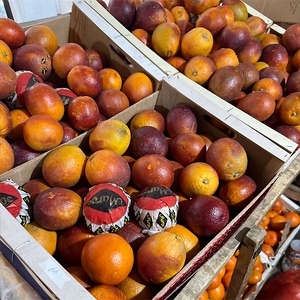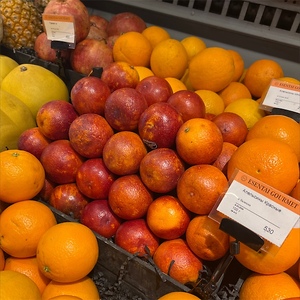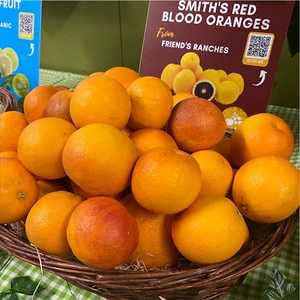


Smith's Red Blood Oranges
Estimated Inventory, lb : 301.00
This item was last sold on : 02/20/25
Description/Taste
Smith’s Red blood oranges are medium to large in size, averaging 5-10 centimeters in diameter, and are ovoid to globular in shape with a slightly depressed base. The medium-thick, orange rind can be heavily covered in red blush and is leathery with a pebbled texture due to prominent oil glands. At full maturity, the rind may be completely red with no noticeable orange. Underneath the outer layer of the rind, there is a white, spongy pith that has a cotton-like texture and the flesh ranges in color from orange with red spots to being fully saturated in deep burgundy hues. The flesh is also juicy, contains a few seeds, and is divided into 8-10 segments by thin membranes. Smith’s Red blood oranges are aromatic and sweet with balanced acidity.
Seasons/Availability
Smith’s Red blood oranges are available in the late winter through early spring.
Current Facts
Smith’s Red blood oranges, botanically classified as Citrus sinensis, are a rare variety that grows on trees that can reach up to four meters in height and belongs to the Rutaceae or citrus family. The red blushed variety was discovered in the 1980s growing on the limb of a valencia orange tree in Southern California and is sometimes referred to as the Smith’s Red Valencia. Today Smith’s Red blood oranges still remain relatively unknown commercially outside of Southern California and are most popular with home gardeners as the tree can be grown both full or dwarf sized. The juicy fruits are favored for fresh eating and are also used in baking, marinades, and for juicing.
Nutritional Value
Smith’s Red blood oranges are an excellent source of potassium, vitamin C, dietary fiber and beta carotenes. The rich red pigment in the flesh comes from the phytonutrient anthocyanin which also offers antioxidant properties.
Applications
Smith’s Red blood oranges are best suited raw and are commonly juiced for use in sweet and savory applications. When juicing and slicing, caution should be taken as the juice may stain hands and clothing. Smith’s Red blood oranges can be peeled, sliced, and segmented for fresh eating, added to smoothies, layered over meat such as poultry and seafood, garnished over cakes and tarts, or tossed into green and fruit salads. The fruits can also be juiced for beverages, cocktails, jellies, marmalades, sauces, marinades, syrups, desserts, sorbets, and infused into salt. Smith’s Red blood oranges pair well with seafood such as snapper and salmon, pork, beets, asparagus, pistachios, dates, mint, leafy greens, ricotta, rose water, lime juice, pomelo juice, and cocoa nibs. The fruit will keep up to two weeks when stored in the refrigerator.
Ethnic/Cultural Info
In Moorpark, California, Merleen Smith initially discovered an orange with red flesh growing on her valencia orange tree, and she thought her neighbor was poisoning her oranges. She contacted the police who turned the fruit over to the University of California Riverside’s Citrus Variety Collection. It was there that experts were able to reassure Ms. Smith that the orange was not the result of poison, but of a natural mutation where the fruit on the tree limb developed the two genes required to create the red pigmentation found in blood oranges.
Geography/History
The Smith’s Red blood orange was discovered in 1988 growing on Merleen Smith’s valencia orange tree in the small town of Moorpark, California in Ventura County. The orange then made its way to the University of California’s Citrus Variety Collection for research and testing. Researchers first planted seeds for the Smith’s Red in 2001 in Lindcove, CA, in the central valley. The results were positive, and they believed the new variety would be a good addition to the citrus industry as the fruits offer a sweet, valencia-like taste. Budwood for the Smith’s Red blood orange was first released to nurseries in 2004. Today Smith’s Red blood oranges can be found through online nurseries and are also available at local farmer’s markets in Southern California.
Featured Restaurants
Restaurants currently purchasing this product as an ingredient for their menu.
| Mabel's Gone Fishing | San Diego CA | 619-228-9851 |
| Fox Point Farms | Encinitas CA | 619-892-0553 |
| Hilton La Jolla Torrey Pines | La Jolla CA | 858-450-4581 |
| Vista Valley | Vista CA | 760-758-2800 |
| Farmer and The Seahorse | San Diego CA | 619-302-3682 |
| Leichtag Foundation | Encinitas CA | 760-230-6772 |
| Rancho Bernardo Inn (Avant) | San Diego CA | 858-675-8505 |
| Omni Hotels | San Diego CA | 619-231-6664 |
| Huntress | San Diego CA | 619-955-5750 |
| Wrench and Rodent | Oceanside CA | 760-840-1976 |
| Monarch School (Nutrition Lab) | San Diego CA | 619-804-1766 |
| Green Dragon Tavern & Museum | Carlsbad CA | 760-797-5579 |
| The Kitchen at MCASD | La Jolla CA | 619-894-2051 |
| Park Hyatt Aviara | Carlsbad CA | 760-448-1234 |
| Wildland | Carlsbad CA | 619-385-0914 |
| Captains Quarters | San Diego CA | 858-412-5237 |
| Blue Water Estate Services | Rancho Santa Fe CA | 858-720-9831 |
| Estancia Adobe | San Diego CA | 858-550-1000 |
| Smokin J's BBQ | San Diego CA | 703-314-1486 |
| Crudo Cevicheria & Oyster Bar | San Diego CA | 619-313-9127 |
| Alila Marea Beach Resort (BQTS Bar) | Encinitas CA | 805-539-9719 |
| Comedor Nishi | La Jolla CA | 619-549-9919 |
| Barra Oliba | San Diego CA | 610-310-5110 |
| Cal A Vie | Vista CA | 760-945-2055 |
| Wormwood | San Diego CA | 619-573-0289 |
| Cardellino | San Diego CA | 619-722-3398 |
| Bridges at Rancho Santa Fe | Rancho Santa Fe CA | 858-759-6063 |
| Marriott Marina Kitchen | San Diego CA | 619-234-1500 |
| Saiko Sushi-Coronado | Coronado CA | 619-435-0868 |
| Callie | San Diego CA | 619-947-9036 |
| Vertex - Merryfield Row | San Diego CA | 619-405-8950 |
| Il Giardino di Lilli | La Jolla CA | 619-467-9897 |
| Secret Sister | San Diego CA | 619-281-0718 |
| Madi | San Diego CA | 320-491-1217 |
| The Shores | La Jolla CA | 858-459-8271 |
| Park Hyatt Aviara (Ember & Rye) | Carlsbad CA | 760-448-1234 |
| Marisi La Jolla | La Jolla CA | 951-852-6730 |
Recipe Ideas
Recipes that include Smith's Red Blood Oranges. One
| Salt N Pepper Here |
|
Winter Salad with Lentils and Herbs with a Blood Orange Vinaigrette |
| The Whole Smiths |
|
Orange Ginger Kombucha Cocktail |



